By Michael Klein in the Summer 1965 Issue
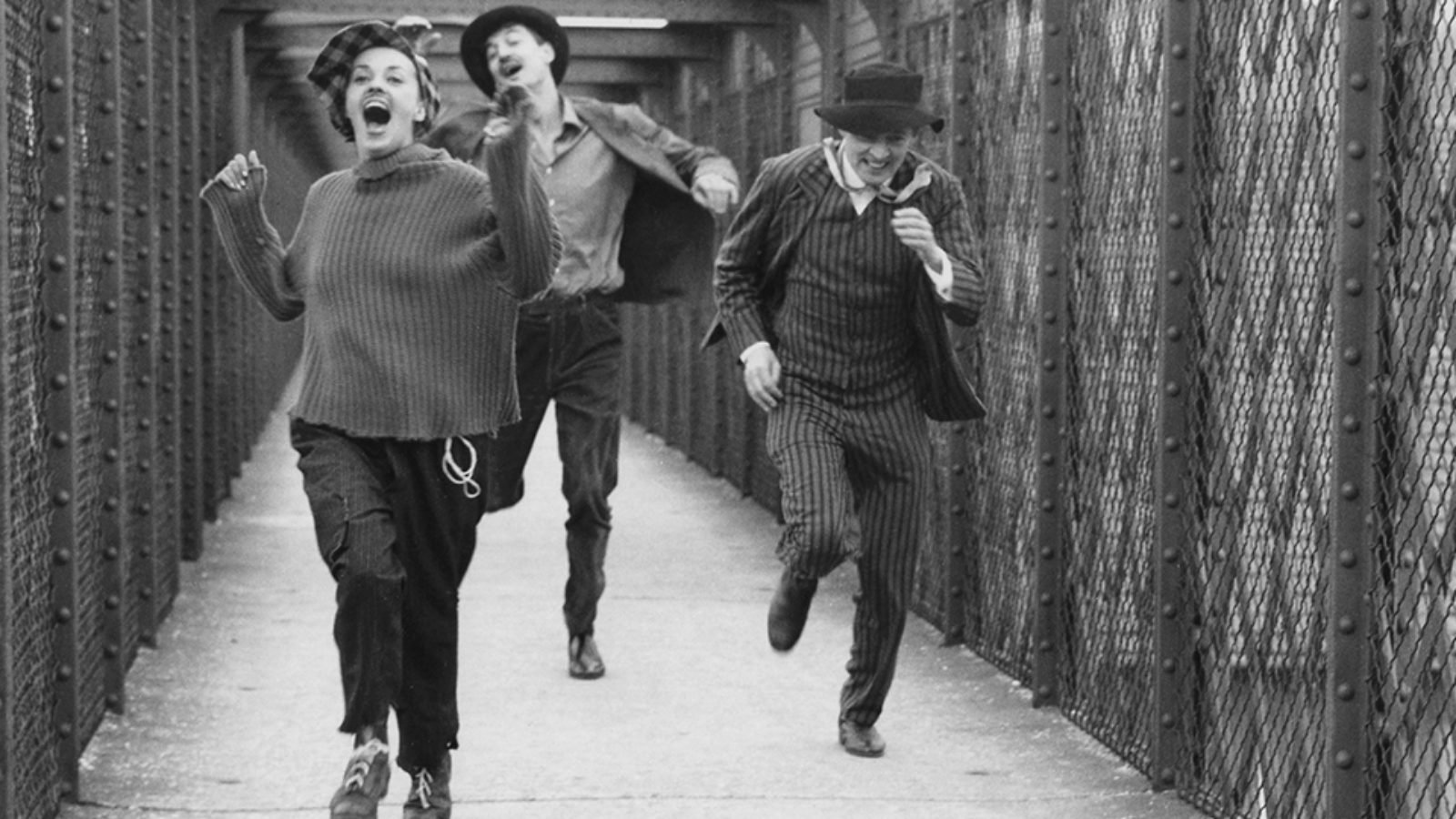
The Literary Sophistication of François Truffaut
On the narrative complexities of the French master’s work
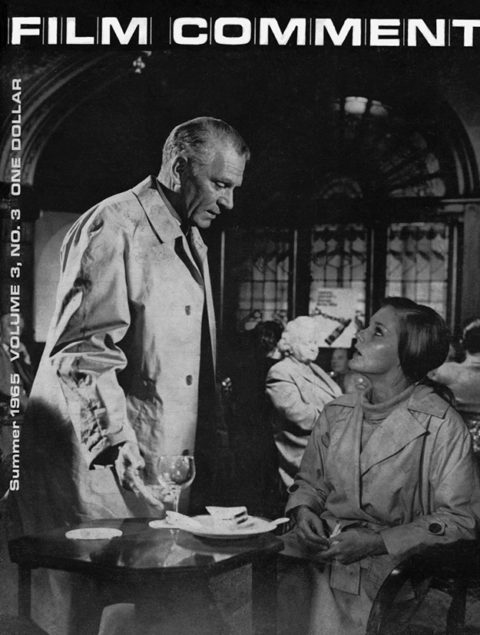
From the Summer 1965 Issue
Also in this issue
Truffaut is not literate merely because his films contain allusions to Renoir, Walsh, Vigo and Hitchcock, although they are the sources of the film conventions he manipulates, nor because Jules and Jim contains references to Shakespeare, Goethe, Don Quixote, Mozart, Picasso, and Baudelaire. Truffaut’s literary sophistication is a matter of technique and sensibility.
Because most films deal with people and situations and tell some sort of story, directors cope with problems that dramatists and novelists face; often they solve them in a way akin to that of their literary counterparts. Resnais in Last Year at Marienbad and Dreyer in Vampyr, for example, maintain a unity of tone that would have pleased Poe. Antonioni probes small incidents and paces his exploration like Henry James.
I would like to focus upon two techniques, interesting in themselves, which help us to grasp the meanings of Truffaut’s Shoot the Piano Player and Jules and Jim. The first technique, used in the modern novel and in continental drama, is the technique of dislocation. The second technique, irony, is basic to all forms of literature. Because I am using these terms in a special sense, especially “dislocation,” I will discuss them before illustrating how they work in Truffaut’s films.
Dislocation, like Brecht’s alienation, is an effect; it is experienced by the audience or reader because it is potential in the art object. When the spectator is alienated, he is distanced from a play or film or story, so that he may respond with the creative intellect. The artist, in employing the technique of dislocation, attempts to prevent this, because he fears his audience will think in conventional patterns. He may fragment the narrative, use an unreliable narrator, distort space, alter the temporal sequence, etc., to this rhetorical end. The dislocated reader or viewer, confused by distortions in the narrative, has to accept the author’s view in order to make sense out of the material.
Truffaut expresses concern, in his interviews, about audience reaction to his films. Like him, playwrights as diverse as Brecht, Genet, and Pirandello have devised new techniques to overcome the difficult problem of communication with an audience. An avant-garde dramatist often assumes that audiences come to a play with a set of commonplace expectations and prejudices that block their relating to the work of art. The artist intends to put his audience in touch with themselves and with the world; that is to say, he wishes to prod and to stimulate by imposing his vision of the world upon their minds and sensibilities. Unfortunately, traditional means of presentation often do not suffice, and the audience has to be lured, tricked and seduced.
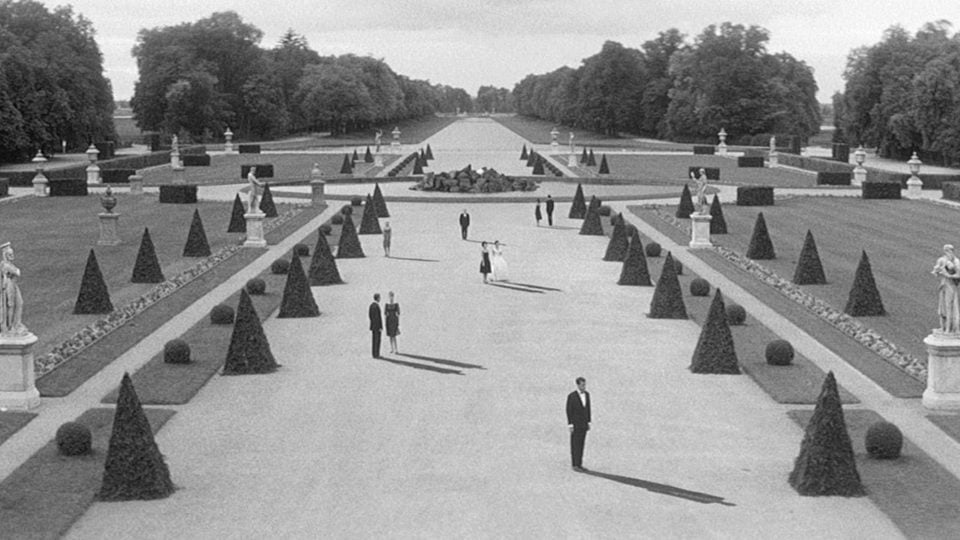
Last Year at Marienbad (Alain Resnais, 1961)
Often this involving of an audience consists of careful manipulation of literary conventions, which are traditional ways of looking at life. This occurs whenever a new literary genre is being created. For example, an eighteenth-century reader of Defoe’s Robinson Crusoe, as Virginia Woolf has pointed out, expected an exotic romance and instead was baffled into accepting an island on which life is a series of tasks. On the other hand, filmmakers like Hawks, Truffaut, and Godard, instead of beginning with a new stylization of life, use old conventions and manipulate the audience’s stock responses to achieve their ends. In this their films share a characteristic of twentieth-century literature.
For example, seeing Brecht’s The Good Woman of Setzuan, we quickly identify with Shen Te. Like us, she is altruistic and generous; like us, she has a fatalistic attitude toward the privations and social injustices of life. She is good and so, like us, believes that individual acts of charity will remedy social problems. Therefore, when she becomes a shop owner, she devotes herself to helping others. Then, after we are trapped, after we have identified smugly with Shen Te, Brecht has her step in front of the curtain and sing revolutionary anti- capitalist songs.
In modern fiction—for example, in Conrad’s Heart of Darkness—dislocation is achieved in a more formalist way, through time shifts, changes in the narrative point of view, and by the use of the literary equivalent of montage—paratactic syntax. I can illustrate dislocation, and thus define the tradition in which Truffaut is working, by briefly looking at a shorter work by Joyce, who imposes his vision also by dislocating us in time and space. “Eveline” begins in the evening; the heroine is seated at her apartment window, in Dublin, waiting for her fiance and thinking about her past. The narrative consists of memories and her judgment of past events. Toward the end, she thinks “Frank would take her in his arms, fold her in his arms. He would save her.” And then, the following paragraph: “She stood among the swaying crowd in the station at the north wall. He held her hand…” This seems to be a continuation of her reverie—she is thinking of how it will be when he comes for her. Only when events take a turn for the worse-the point of view (Joyce’s) suddenly becomes distanced and objective—do we realize that this is an account of her failure to elope—she is now at the station, not dreaming but unable to act. She is paralyzed.
He rushed beyond the barrier and called to her to follow. He was shouted at to go on but he still called to her. She set her white face to him, passive, like a helpless animal. Her eyes gave him no sign of love or farewell or recognition.
The conclusion shocks us into a multiple recognition: of Joyce’s trick; that Dubliners live in a dream when awake; of Eveline’s awful failure; and of the sterility in Dublin life that has made her what she is.
Because reading is a temporal experience, our perception of a story can be viewed as a process. Prior to our recognition, we were confused by Joyce’s shift of time and place. At some point between the paragraph that begins “she stood among the swaying crowd” and the concluding paragraph, we, the audience, are uncertain whether the events are taking place in the girl’s mind or at the station. Baffled, dislocated, we are receptive to the particular solution that Joyce wishes to give us.
Another example of dislocation. Seeing Renoir’s Rules of the Game, we relax and enjoy a good comedy. Renoir tells us in the credits that the film will be fun. We may sense implications, but they are not disturbing. We accept the film. The maid’s husband is chasing her would-be lover with a gun, upsetting the crowded household. It is very funny. Suddenly, after the dance macabre, the gun is fired—a lamp is shattered in the foreground and the main characters become frightened. For a second it seems as if the host is shot. The film becomes serious. But it is unexpected. We’re stunned, and the film continues to develop before we can build up our conventional defenses against Renoir’s vision.
This last example is similar to Truffaut’s use of guns and knives in Shoot the Piano Player. But before illustrating this technique in relation to his films, I must briefly discuss irony.
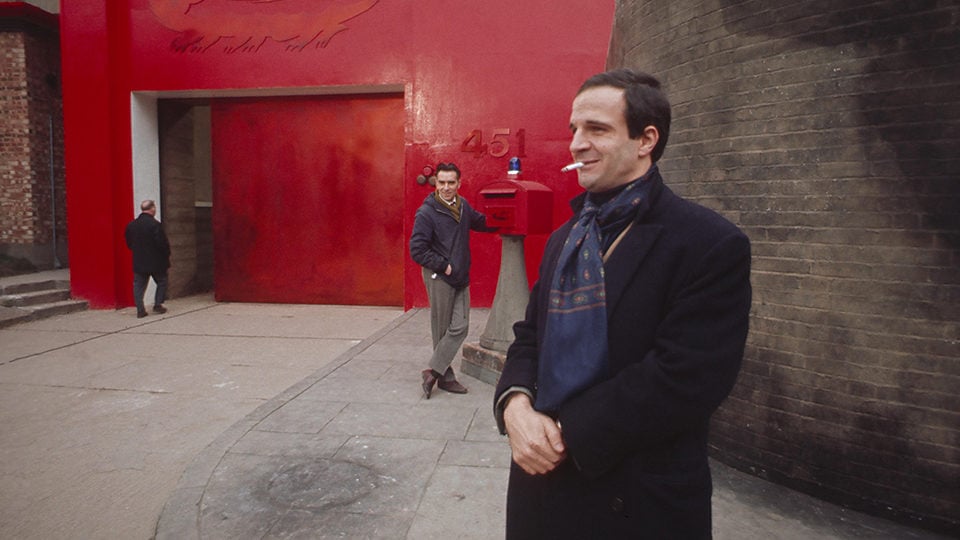
François Truffaut on set of Fahrenheit 451 (1966)
In literature, irony may be achieved by subtle manipulation of language. Shakespeare’s Troilus and Cressida begins with a speech by a Prologue who, in epic tones, fills in the background of the Trojan War. He speaks a highly formal latinate language; it is like Chapman’s Homer, which praised the war as a moral struggle. “In Troy there lies the scene. And the deep, drawing barks do there disgorge/their warlike fraughtage.” However, if we examine the language carefully we discover that it undercuts itself. It is anti-heroic and critical of the war. “Disgorge” suggests vomit; later in the play the Greeks are often associated with disease. “Fraughtage” refers to cargo; later the Greeks are linked with commercial terms. They are not noble warriors. They are merchants out to ransack Troy for plunder and profit.
In the early books of Paradise Lost Milton uses a similar technique to ridicule Satan. Like Milton, many authors manipulate their audience in order to make a limited and specific critical statement. At worst, these techniques may serve authoritarian or propagandistic ends. However, they also can function to enlarge the audience’s vision of life. In literary terms this is called creating ambiguity. Techniques are used to make the audience accept several meanings of an incident instead of to simplify experience: this is the spirit of plentitude, and is basic to Truffaut.
Perhaps one final example from the drama will be useful. Ionesco’s The Lesson concludes with a “murder.” The Professor stabs the Pupil with an invisible knife because she has a toothache. Up to then the situation has seemed comic. Now the violence of the act impels us to view it as a killing. “Aaah! That’ll teach you! (Striking the Pupil with a very spectacular blow of the knife).” But as the girl falls “her legs spread wide.” “A noticeable convulsion shakes” the Professor and he says: “Bitch… Oh, that’s good, that does me good.” It is, as well, a rape.
Truffaut also uses techniques of dislocation and irony, often in the spirit of plenitude. In Shoot the Piano Player they tend to be ends in themselves. In Jules and Jim they are used to make us recognize the richness and complexity of the character’s lives and to view their experiences with tolerance.
Throughout Shoot the Piano Player Truffaut juxtaposes different conventions or genres in order to dislocate the audience. The film begins with a conventional gangster chase that quickly becomes slapstick. Yet at times it seems to be a serious psychological study of Charlie. And during the flashback scene, it appears to be a conventional success-and-fall-of-the-performer film (complete with a shot of the concert pianist from in front of the footlights). At other times it seems to be a story about an honest, tough waitress’s attempt to help a laconic, broken piano player. The film concludes in a slapstick gun battle, with a breathtaking Hitchcock form falling down a white hill, and with the killing of the waitress and with Charlie benumbed.
All of this makes us unable to decide what kind of a film Shoot the Piano Player is. We cease forcing it into our narrow system of classification and instead have to take it on its own terms. Truffaut’s use of irony within conventions that are so radically juxtaposed also contributes to this end. Often irony makes us uncertain of how to react to even an isolated section of the film. However, it also guides us to respond in a sensitive way.
For example, consider the flashback scenes. It is a wonderful parody of the Horatio Alger success myth, plus Antonioni. A young boy, whose brothers are hoods, is sent to study with a famous pianist, is discovered by chance in a restaurant, and enjoys a spectacular rise to fame—concerts, interviews, more and more expensive cars. But he and his wife are bored and increasingly estranged. His wife confesses that she slept with the producer to get him discovered. The piano player makes a dramatic exit. She jumps out a window, and we see her corpse on the street.
It is an excellent parody of something that, with variations, has been done so many times. However, ironically, it isn’t what we expected. The suicide gives us a jolt and we view the problems raised as serious. In short, Truffaut has rendered a cliche by parodying it. He has made us respond to a situation that, portrayed in a straightforward consistent manner, would have been dismissed easily.
The conclusion of the film works in a similar way. By ironically undercutting the gun battle and making it slapstick, Truffaut is able as well to render it as serious. The bad guys sniff their gun barrels and twirl the guns. They are perturbed and ridiculous. Lena is running. They shoot. Lena is dead. We see Charlie and her corpse in a brutal closeup.
The techniques work to make the film both extremely funny and extremely serious. Parody operates upon a dislocated audience to render meaningful a cinematic cliche. Charlie is not just the conventional Alger hero or the conventional laconic loner made funny. He is also a person to whom we respond with sympathy and horror. Shoot the Piano Player is both a gangster comedy and a study of a disillusioned man in a preschizoid state of withdrawal.
Truffaut’s use of cliches is best studied in Shoot the Piano Player. A cliche is an overused convention. It is a symbol that no longer evokes powerful responses in audiences but still stands for something basic. Instead of creating new symbols for universal experiences, Truffaut works to resuscitate traditional
signs.
However, the film ultimately is a magnificent exercise in technique, an astounding formalist tour-de-force, rather than a dramatic success. The techniques are used better, in a more integrated way, in Jules and Jim.
Techniques of dislocation are less obvious but equally effective in Jules and Jim. Consider, for example, Dwight Macdonald’s response: “I was constantly being buffeted, shocked, puzzled and put off by what seemed to me perverse changes of mood.” At times the film seems charming and idyllic. Other sections seem a probing study of love and friendship. Sometimes it appears to be sentimental. But then it becomes sharply satirical. The cremation scene is graphic and brutal. But the car plunge into the river is visual slapstick. Parts of the film are slowly paced and the frames look static. But in the early part of the film the characters are in motion and Truffaut’s audacious cutting is sufficient itself to make the audience breathless—to disarm the audience.
While Truffaut buffets and dislocates the audience, he asserts that all these ways of looking at the story of Jules and Jim and Katherine are valid, that life is more complex than the categories with which we attempt to understand it. The form or technique of the film expresses the theme.
Let’s see how this works at the conclusion of the film. Most of the scenes in the German Chalet are directed in a straightforward manner. Suddenly the cutting becomes more erratic and genres are again mixed. Katherine brandishes a gun and Jim disarms her in detective film style. Albert re-appears—a whacky coincidence, too whacky for a “serious film.” Katherine’s and Jim’s death is slapstick, hut their cremation (hot bones and ashes) is sickeningly real. Jules, numb and griefstricken, is leaving the cemetary. The narrator tells us that Jules feels relieved. The music is gay—a cliché Hollywood crescendo. These shifts in style and tone exhaust the audience’s conventional responses.
Our view of Jules at the conclusion is most important because this is the focal point for our response to the whole film. Is Jules relieved or is he sad? Is he relieved and in grief? Our answer depends upon whether we are relieved or grieved or both, and this determines our view of Katherine. By making Jim’s and Katherine’s death slapstick, Truffaut prevents us from responding in a conventional, sentimental way (cry, don’t think, quickly forget), which would have been a monstrous oversimplification. Because it is unexpected, the cremation scene makes an impact. We are shocked by “life,” not by a serious film. But this is a visceral response. The gay music is then first heard as irritating and puzzling. The music is trite and inappropriate and we attempt to deny it. (It is like jumping on stage and interfering with the action, preventing a murder.) We became involved and respond from within the film. We experience grief and empathy. However, the music and the narrator cannot be completely ignored. As Jules begins to become distanced from his past experience, we also begin to become distanced from the film.
The beginning of the film is as crucial as the conclusion. In the opening scenes Truffaut uses irony to undercut, and it functions to enlarge our conception of life, not to make a specific statement of ridicule. The film is paced fast. The music is gay. Jules and Jim begin an idyllic friendship. Jules meets Katherine. She gets into a tramp outfit and all three go out for a romp. They race across a bridge. Katherine starts early and wins. Jules and Jim are laughing. At first we are charmed by the scenes, but we begin to feel that the music overstates a bit; it is slightly too gay for the action. The cutting is too abandoned, slightly hysteric. We become suspicious—it is a bit forced and overdone. Therefore we take a close look at the bridge scene. It seems significant that Katherine jumps the gun in order to win. We watch her face contort while she is running and mark her ecstatic cry of victory. Katherine must defeat Jules and Jim—she must exert power. She must cheat, and then run hard to beat them. And she knows they are unsuspecting. We are horrified; our expectation of innocence is destroyed. And yet the race isn’t just a parable. The music is gay. Jules and Jim are happy. All three are having a good time. They look beautiful. And silly. The scene, then, is both an idyll and an ironic rendering of a cold psychological truth. It is both innocent and diabolic. Because we suspect the idyll, it becomes more important. We are charmed and we are horrified. In the same way—Catherine’s leap into the river, a mad youthful funny impulse after a dull night at the theater, yet threatening.
The result is ambiguity and plenitude—maturity. We respond to life in the film in a complete way. First of all, we do not judge the characters as we would in life or in a conventional film. We do not wish to punish them. Truffaut admired Renoir’s Rules of the Game because it was “the first psychological film in which the notion of a good and bad personage had been entirely eliminated.” He has qualified his admiration for the gangster film by disliking its simple good/bad dichotomy and its cruel code of justice. His The 400 Blows is a protest against our concepts of crime and punishment. Truffaut uses all the techniques at his command to get us to see life as complete, to regard life with tolerance.
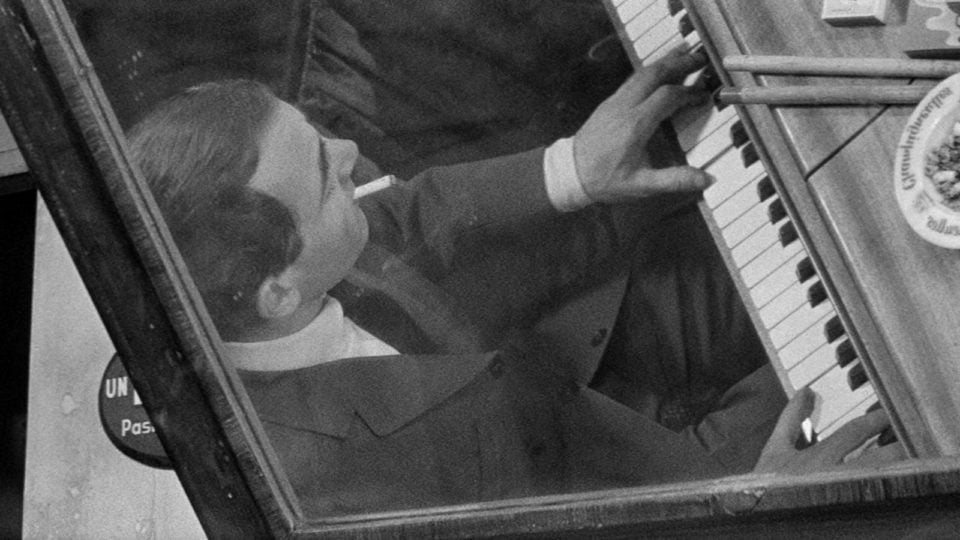
Shoot the Piano Player (François Truffaut, 1960)
Katherine, then, is not just a demonic uber-fraulein (the term is Truffaut’s)—a self-absorbed, insecure monster who forces people to serve her will. Nor is she merely a paragon of moral courage and a person of great charm who brings happiness and catalyses a “beautiful relationship” (Truffaut again). She embodies both polar concepts, and all that is in between. Jules and Jim are not only silly romantics who overvalue Katherine, silly and repulsive herself, questing for a childhood idyll. They are not just mature, intelligent, sensitive men courageously acknowledging the problems of life and attempting to cope with them. They are both “types” and more.
Jules emerges as the most interesting character because of the role he plays in relation to the theme of tolerance. Slightly withdrawn, he is compassionate and accepts life as complex and responds to it on its own terms. Jules seldom judges Katherine but instead attempts to make the best of their lives. He is not vindictive; he instead attempts to arrange for Katherine’s and Jim’s happiness and to salvage a bit for himself.
Katherine, on the other hand, has a vindictive sense of justice. She keeps a bottle of vitriol for “lying eyes.” She sleeps with a former lover to punish Jules, whose mother was rude to her, and to punish Jim for tarrying with Gilberte. She demands justice, simplicity and a clean slate. But she believes that the ultimate judge is compassionate toward her. “She thinks that whatever she does, God will forgive her in advance.”
Society, pre-1930, is viewed as tolerant. It nurtured Jules, Jim and Katherine and the “free life” before the war. In Germany, in the 1920’s, people have a similar spirit of tolerance. The village people were startled by the ménage à trois and by their antics. “The village called them the three lunatics, but respected them.” After Hitler, things change and significantly Truffaut shows us film clips of Nazi book burnings when Jules, Jim and Katherine meet in a movie house after long separation.
In the novel Jules was Jewish. This would have complicated the movie. Truffaut’s literary sophistication is evident in the way he adapted the social and political elements of Henri Pierre Roche’s novel. Our stock responses to Jews and Nazism would have galloped roughshod over the delicate psychological balance of the film. Truffaut retained a sense of history but made it function within the film in relation to the tolerance theme and subordinate to the ménage à trois situation.
The progress of the characters’ lives reflects the history of the times during the twenty-plus years of the film. Life is simple before the war, more complicated after the book-burnings. As we approach the time of the book burnings the uber-fraulein aspect of Katherine becomes stressed. Katherine brandishes a gun at Jim. She wears steel-rimmed glasses and begins to look “Germanic,” especially when we see her immediately after the film clips. Then follow suicide, immolation, cremation and the graveyard scene. The cremation might suggest Nazi death-camps-willful Katherine is linked with fascism.
The symbols in Jules and Jim are handled with skill and subtlety, for example, Jules and Katherine’s child (Sabine) plays a game at the chalet. It is, first of all, a charming dance and romp. Soon Jim and Katherine appear—more antics. But the game is Sabine (a reflection of Katherine) whipping Jules and making him skip to her lash. It is a concise symbol of Jules and Katherine’s idyllic-demonic relationship.
Truffaut’s symbols seldom force themselves upon the viewer. Katherine, who loves power, may be characterized as “Napoleonic.” She briefly mentions Napoleon and in Katherine’s room there was a photograph of Napoleon on the wall, out of focus and scarcely noticeable. In the chalet Katherine sings a little pop-song about love and missed kisses. It is a light moment. But the song—together we are caught-up in life’s whirlpool—sums up life in Jules and Jim.
And automobiles are obvious symbols of the new technology: a car first appears in the Le guerre social scene, while last is Jim’s and Katherine’s death car. Bicycles represent the old life. But cars are first of all cars, and Katherine’s car functions as a device of characterization; it is an extension of one aspect of her personality. Curiously, it resembles a hearse, particularly when she drives it silently, ominously around and around the little corner square in front of Jim’s house.
Aside from the literary aspects of Truffaut’s films, other factors are equally important: Truffaut’s joy in the process of filmmaking (the home movie spirit of his films); Coutard’s photography (horizontal motion—the camera, dance rhythms within the frame). I have focused upon Truffaut’s literary sophistication because, in addition to his good heart and a good eye, few filmmakers have his quality of mind.
In this article I have attempted to work from a critical approach that applies both to film and to the literary arts, and which may also be a guide to filmmakers. For insofar as an artist is able to structure and to manipulate, he succeeds in creating a work of art that will haunt his audience. That is the ultimate test of a film, play or novel.







